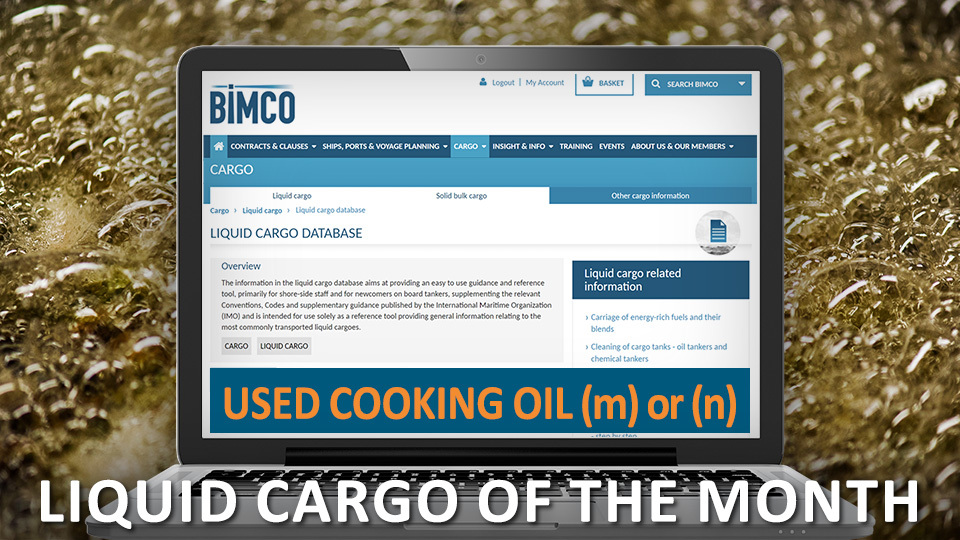Liquid cargo of the month – Used Cooking Oil (m) or (n)
Published: 21 September 2023
The BIMCO Liquid Cargo database is intended for use by for shore-side staff and to some extent for newcomers on board tankers and should only be used as a reference tool providing brief information regarding the about 310 of the commonly transported liquid cargoes including
Used Cooking Oil.
Trade name/synonym name: UCO; Yellow grease; Used Cooking Oil-Recovered vegetable oil; WVO (Waste Vegetable Oil); SVO (Straight Vegetable Oil)
Dark/light brown liquid. The substance is not classed as hazardous. However, as the origin of each shipment of Used cooking oil is not completely known, IMO has decided to denote the substance in IBC Chapter 16 column (d) as "S/P". This indicates that Used cooking oil is considered to pose both Safety- and Pollution hazards
Relevant additional IBC requirements:
15.19.6 high-level alarm and 16.2.6 cargo's viscosity at 20 deg. C, or the temperature at which the cargo has a viscosity of 50 mPa.s shall be specified in the shipping document
16.2.9 cargo's melting point shall be indicated in the shipping document
Shipping Document: Cargo's viscosity at 20 deg. C, or the temperature at which the cargo has a viscosity of 50 mPa.s shall be specified in the shipping document. Cargo's melting point shall be indicated in the shipping document
Carriage requirements:
Heating during voyage > 40 deg. C but obtain heating instructions from shipper
Heating during unloading > 40 deg. C but obtain heating instructions from shipper
Tanks inerted or padded Not required by IBC
Prewash required. Cargo is pollution category X
Tank cleaning: Prewash, ambient/moderate temperature water wash - not hot temperature as some components in the Used cooking oil might have properties similar to "drying oil".
Prewash to be discharged to shore reception facility at port of unloading.
Moderate temperature water wash. Keep temperature well above melting point
Hot temperature water wash
Ambient temperature freshwater rinse, if sea water was used above
Recirculate with caustic soda or caustic potash solution or use a cleaning additive with saponifying properties. For zinc tank coatings only use an approved cleaning additive which will not attack the zinc coating
Ambient temperature freshwater rinse
Hot surface of heating coils could cause decomposition under formation of Carbon Monoxide (CO) during unloading operations
Attention: Always monitor CO concentration before and during tank entry. (TLV for Carbon Monoxide, CO is 25 ppm)
(m) in the proper shipping name for Used cooking oil (m) means that this entry can be used for products made from vegetable oils, animal fats and fish oils specified in the IBC Code
Precautions: Used cooking oil is considered a drying oil.
This compound thickens and becomes rancid on prolonged exposure to air. Before loading any white petroleum oil cargo after the carriage of vegetable oils such as Sunflower seed oil, clarification of cleaning procedures should be obtained from the charterer/receiver
IBC Code chapter 17 also lists the entry: Used cooking oil (Triglycerides, C16-C18 and C18 unsaturated) (m) (n).
This cargo is pollution category Y.
To use this Product Name, the shipper will need to confirm and provide documentation that the Used cooking oil cargo composition contains triglycerides, C16-C18 and C18 unsaturated. Otherwise, the more generic entry "Used cooking oil (m)" must be used.
The BIMCO Liquid Cargo Database contains information on some 310 cargoes, all updated to the IBC Code 2021 amended requirements, but to ensure that the
BIMCO Liquid Cargo Database information is kept updated, we highly welcome any feedback in the form of comments, response, information or data regarding a specific cargo.

